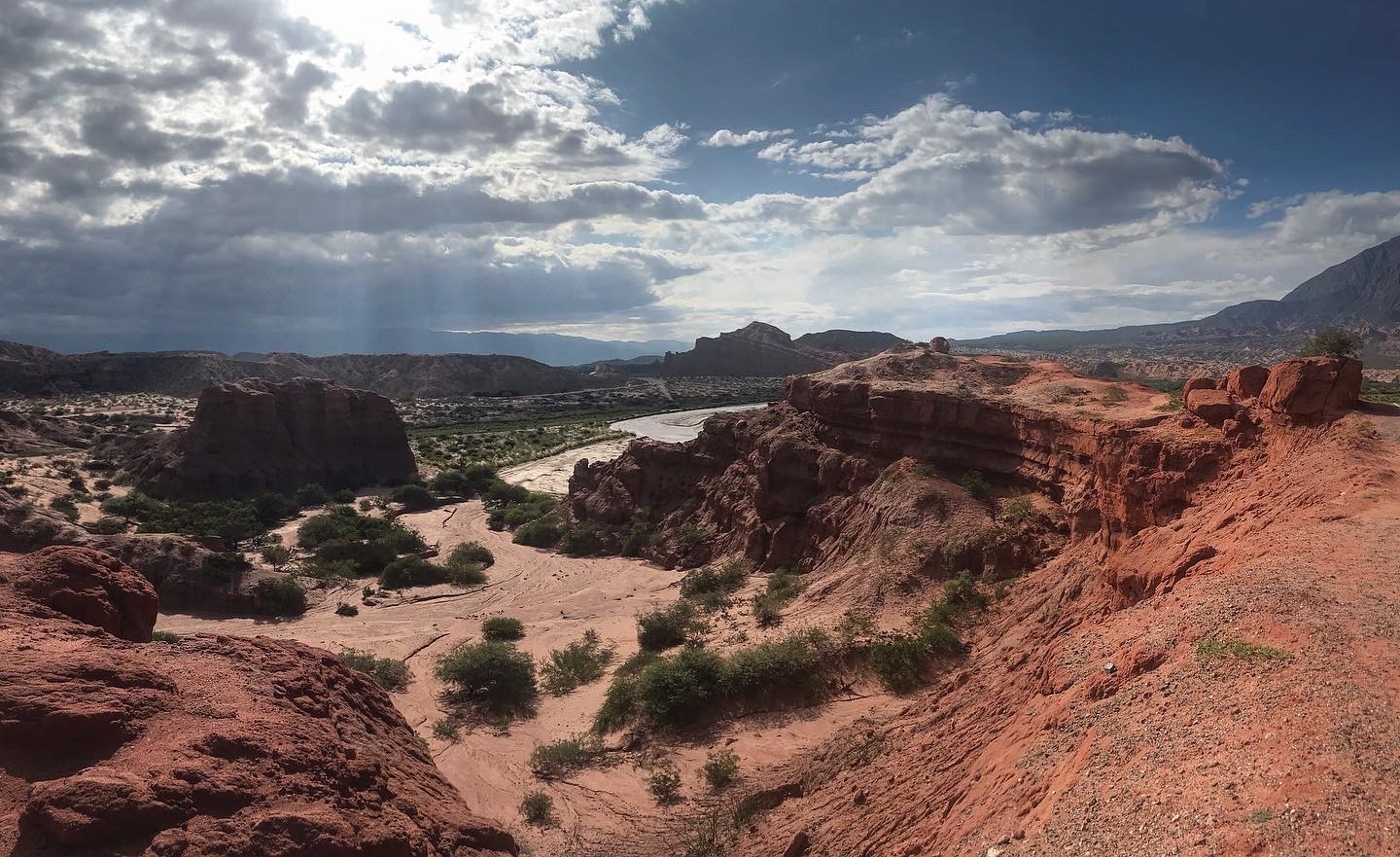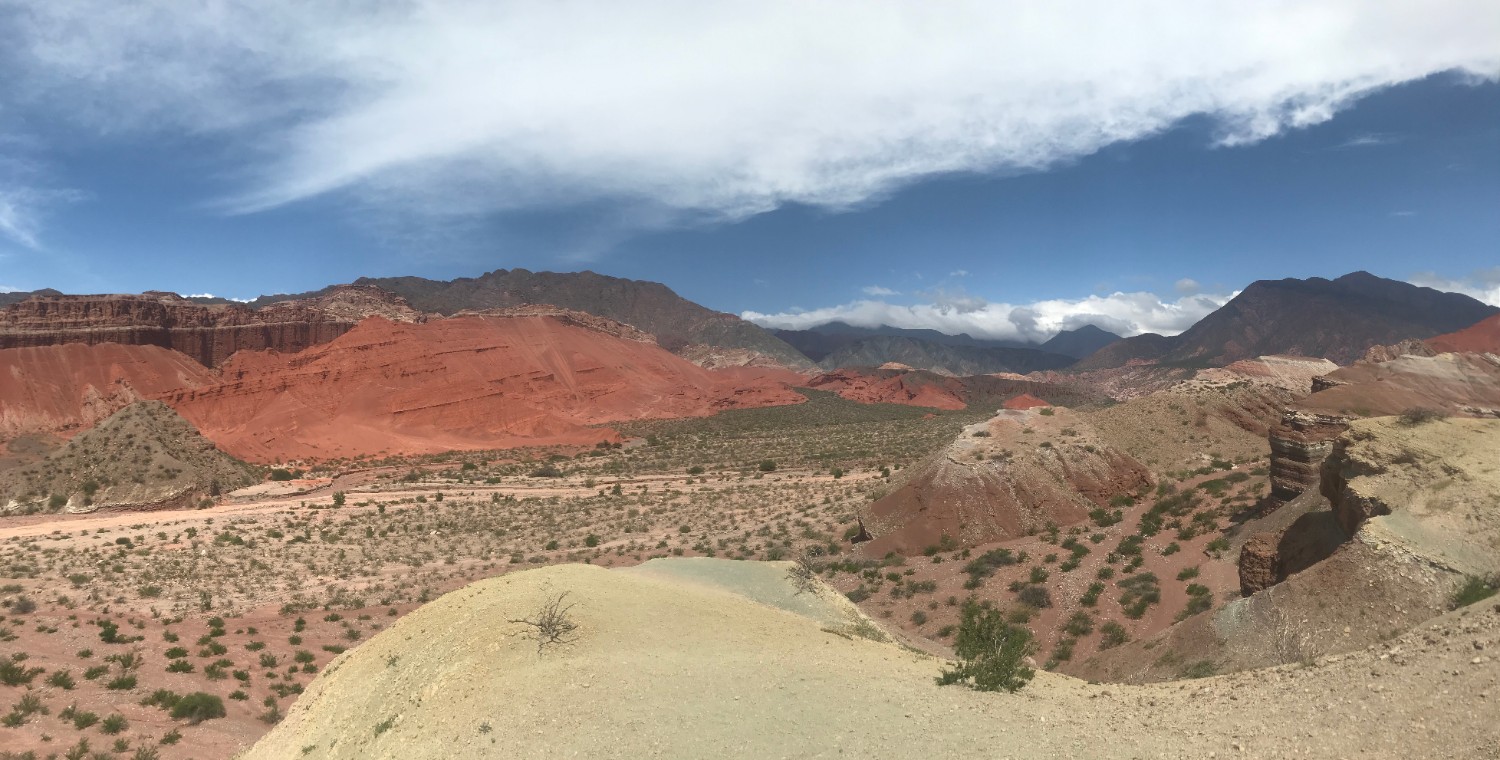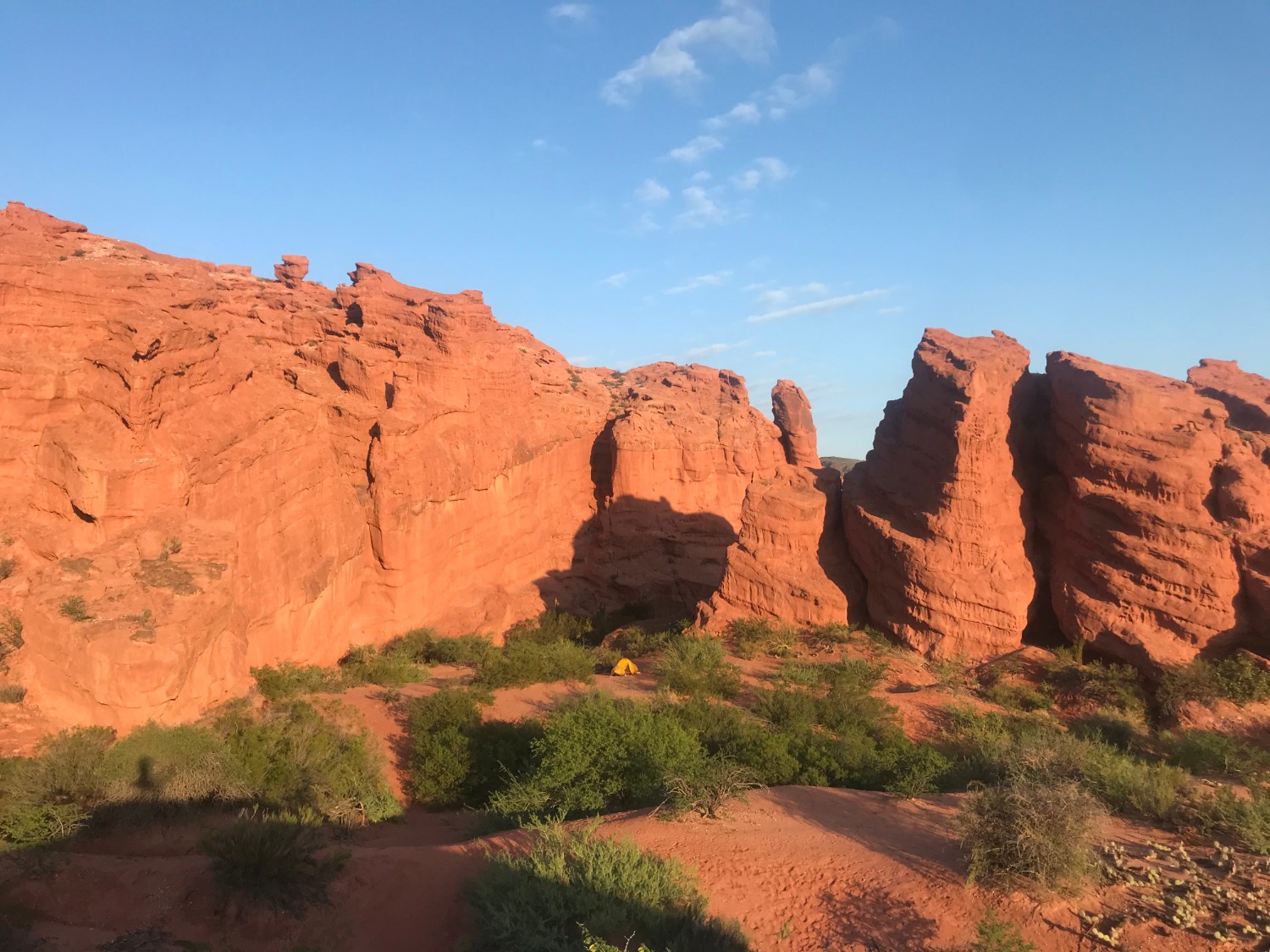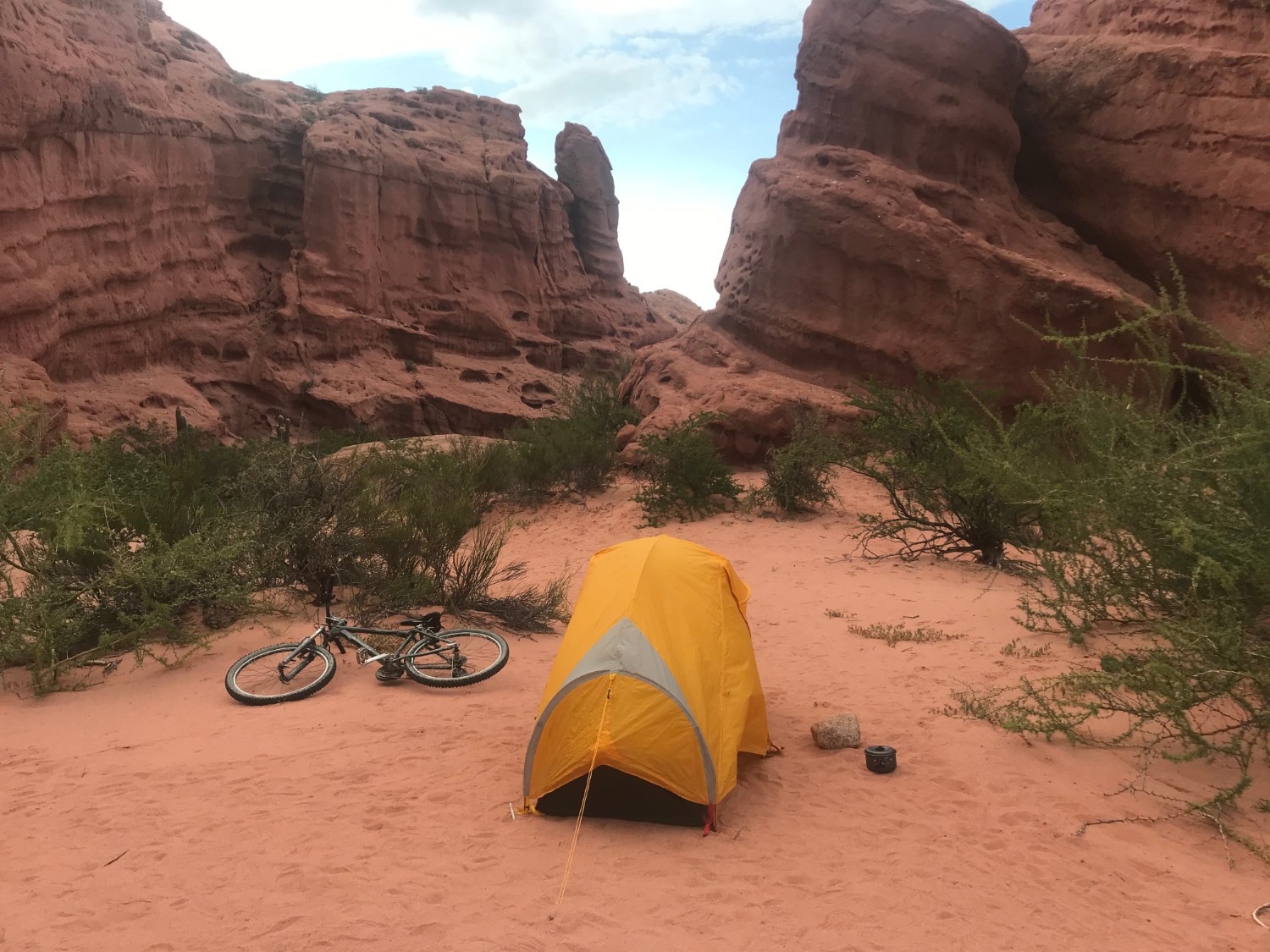Solo camping in Argentina turned into quite the adventure for Anna Richards. She shares her experience plus plenty of advice if you want to strike out on your own grand adventure!
My tent had become a basement club. The grungy, rumbling beat from the incessant rolling of the thunder reverberated through the damp sand and broke overhead.
The epilepsy-inducing lightning split the sky and caused the tent interior to light up like a strobe light.
I was miles from the nearest town and the only metal in this barren landscape was my tent poles and the rickety old bicycle propped up outside. Not even a tree for miles.
The flashes of light felt so close that I was convinced one would hit and I’d be frazzled to a crisp. Burnt alive in the desert.
Exploring the Argentine Desert
The trail through Argentina’s North-West from La Garganta del Diablo (The Devil’s Throat) – which is a short distance south of Salta – to Cafayate – home to the highest altitude wine in the country – is a well-trodden one.
Vast, weather-worn pillars of sedimentary rock create an arid, otherworldly landscape of towering geoforms too numerous to count.

Day tours run from Cafayate to tick off the main highlights.
The more independent travellers often choose to hire motorbikes or bicycles to explore the area at a more leisurely pace.
Cyclists typically catch a bus from Cafayate to La Garganta del Diablo, 50 kilometres from town, and pedal back.
Doing the route this way round has you cycling on the flat or downhill most of the way, which is vastly preferable in the desert.
Visit Cafayate in Argentina
Cafayate is easy enough to reach. The closest big city, Salta, has an international airport and buses run regularly from the main bus terminal down Ruta Nacional 40 south to Cafayate town.
Ruta Nacional 40 spans almost the entire length of Argentina. The section down from Salta is one of the most scenic, so it’s well worth doing in daylight.
I spent five days there. There are lots of great day hikes in the area and a day or two to roll around the various bodegas is a must. Other than a few in the main town, they’re fairly spread out so a bike is useful for getting around.
The foodie scene is great, too. La Casa de las Empanadas is a fantastic, cheap way to soak up a day’s excesses at the vineyards.
After several days of quaffing Cafayate’s famous Torrontés (white wine from the region) in abundance, I opted for a bicycle.

Prepping for a Desert Cycling Adventure
There are numerous bicycle rentals around the main square in Cafayate and many of the hostels also have bikes for hire, but not all of them will let you take a bike overnight.
One place I found that did was the tourist information office on the main square.
All of the rental offices assured me that there would be no issue getting my bike on the bus to La Garganta del Diablo, so I was a little taken aback when I arrived for the 10am bus and the bus driver refused point-blank to take it.
The bus, he said, was already very full. Passengers were not travelling light.
Buses on that route are infrequent and if you have a bicycle then you should take the 8am bus, something all of the bike rental shops had failed to tell me.
After considerable persuasion and a game of suitcase Tetris, the driver relented and I squeezed my bike into the hold.
As a result, I was the last person on the bus. Only one seat was left, right at the front, next to two impossibly clean-looking boys with severe partings, blindingly white shirts done up to the neck, and identical little ring-binder notepads in the breast pockets.
I scrabbled in my bag for my headphones to jam hastily into my ears – but too late. The closest of the boys had already leaned forward, smile wide, to ask ‘de donde sos? (where are you from?)’
Elder Billy and Elder Gonsalez were informally known as Cameron and Matias, from Chicago and Asunción respectively, but they asked me to keep the ‘Elder’ when I addressed them.
At La Garganta del Diablo I practically fell off the bus in my efforts to escape, armed with plenty of new reading material on José Smith and a design for a gaudy-looking new church of the Latter-Day Saints.
Cycling and Camping Near Cafayate
So began my journey in the Argentine desert. Ahead of me lay 50 kilometres to travel by bike down the Ruta Nacional 68, running almost parallel to the Ruta Nacional 40 that I’d travelled down by bus.
The swirls on the multicoloured mountains around me looked like thumbprints. The combination of heat and red dust created a hazy mirage on the road in front of me.
El Sapo, Los Castillos, La Fraile (The Toad, The Castles, The Monk)…geological marvels peppered the landscape on either side.

The combination of the physical exertion of pedalling a broken bike through the desert at midday and the sheer scale of the sandstone monoliths took my breath away.
Maps of the many landmarks are readily available from the tourist information centre and hostels.
I camped amongst the crumbling sandstone columns of Los Colorados, leaving me about 17kms to make it back to Cafayate the next day.
Climbing up to a vantage point across the valley, my tent was little more than a yellow smudge in the rust-coloured landscape. I could blot it out with my little fingernail.
The only running water nearby was from a muddy river and, despite doubly purifying it, my polenta took on a grey and gritty appearance. I considered filtering the water through one of my socks but smelt it and immediately thought better of it.
I’d passed several little shops and restaurants earlier in the day and should have stocked up with enough water for the night.
The best advice that I can give for camping in the Argentine desert is to take twice as much water as you think that you’ll need. And then a little extra, just in case.
A Desert Rave for One in Argentina
The last of the aforementioned daytrippers from Cafayate arrived shortly before dusk.
“Camping all alone?” asked a man from Tucúman with more hair on his upper lip than on his head. “You’re brave. The rocks here are full of snakes.”
“Camping all alone?” asked a woman from Buenos Aires, wobbling precariously in stilettos that sunk into the soft sand with each step. “You’re stupid. The rocks here are full of snakes.”
I didn’t feel stupid. In fact, I felt pretty smug as the sun dipped behind the great, eroding pillars.

It was so still, not a breath of air, and (more importantly) not a snake in sight. Darkness fell abruptly.
The stars came out one by one like glitter and I lay on my back marvelling at how clear they all were and how deliciously alone I felt until the cool night air forced me to retreat into my tent.
I wasn’t asleep for long. Rainfall in the Calchaquí Valley is about as infrequent as the discovery of a gold tablet containing instructions from God on the hill above your house.
My little tent lurched drunkenly, guylines straining.
The strobe light intensified, torrents of water dipped the canvas, like dripping walls in an overcrowded club.
The thunder boomed and pulsed. I read my pamphlet on José Smith in a desperate attempt to distract myself.
How many people die each year from being struck by lightning? I wondered. Which would be more painful, death by lightning or death from a snake bite?
I felt a little nauseous with fear, the sensation you get when you stand still on the dancefloor but the ceiling spins and you realise you’ve had one tequila too many.
I buried my head inside my sleeping bag and shut my eyes as tightly as I could. Boom, boom, boom. The tent convulsed and the lightning flashed again and again.
The Aftermath
Copper sand had turned to thick clay as the first fingers of light warmed the landscape, the sky aflame.
I had survived the night.
Mud churned under my bicycle tyres, splattering me from head to toe like a Jackson Pollock canvas as I drew closer to Cafayate town.
Wild-eyed and dirty, I stopped at the first sign of civilisation: a café on the outskirts of Cafayate town. The waitress hastily ushered me to a table outside, away from the other guests, and sat me next to two incontinent llamas.
The sky was devoid of clouds and innocent-looking, the rave of the night before forgotten. The thudding, thunderous beat had been replaced with birdsong and the clink of teaspoons on saucers.
I tucked into steaming, grit-free black coffee and hot bizcochos (a type of savoury breakfast biscuit) as I scoured dried mud from my body using my booklet on José Smith, the llamas pissing and spitting happily next to me.
All images courtesy of the author.














































